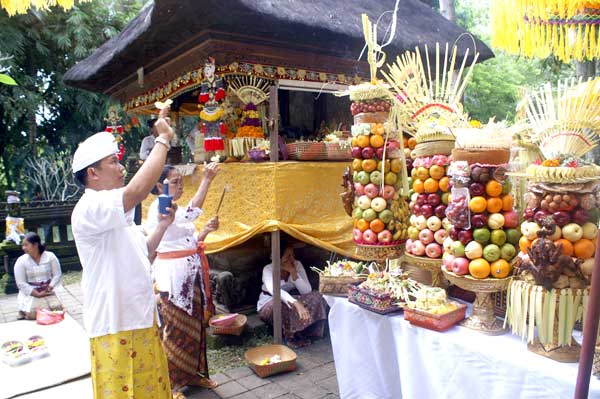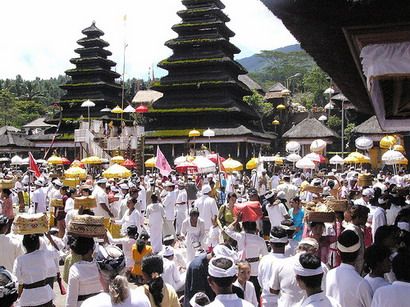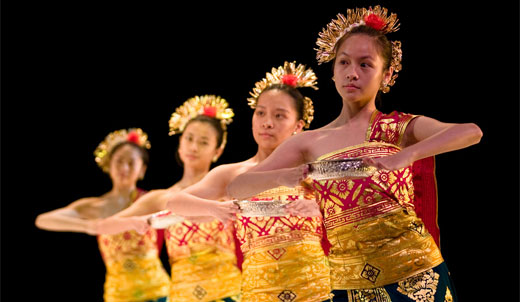Every six months the Balinese Hindus celebrate the great day of Galungan when the ancestor spirits come down to the earth to dwell again in the homes of their descendants. The spirits are entertained and welcomed with prayers and offerings.
‘Penjors’, long bamboo poles are erected together with a little bamboo altar from which hung a ‘lamak’, one of those beautiful mosaics on long strips of palm leaf on all the roads and the gate of every home. Commerce practically ceases during the Galungan days. Schools are closed, and the normal life of the village concentrates exclusively upon the events surrounding this very sacred period.
On the Sunday before Galungan, called Panyekeban, green bananas are sealed in huge clay pots. Lots of bananas are required for Galungan offerings, and this treatment will ripen them quickly. The next day, called Penyajaan, is devoted to make many colored cakes of rice dough (jaja) that are used for offerings. The markets are full of ‘jaja’ in many kinds, so the busy housewife can buy them.
On the day before Galungan or Penampahan, pigs, chicken, ducks or even cows are slaughtered for the traditional Galungan day feasts. Featured at these feasts is the traditional ‘lawar’, a spicy mixed vegetable with finely ground meat and dozen of spices.
Galungan day is a time for prayers, the kids wear new clothes and the whole of Bali went out for a great praying at ‘puras’ or ‘merajans’. The women dress in beautiful ‘kebayas’ and ‘kambens’ (two or one half meters long, but slightly narrower than sarongs). A woman always wraps her body with ‘kamben’ tightly, so it will performs a graceful figure. Some women make some pleats on their front side of ‘kambens’ and hold it with a flat hairpin alike. The men wear white clothes and ‘destar’ (scarf that tied on the head). They also wearing ‘kambens’, but wrapped in the different way with the women. When a man wraps the ‘kamben’ he ends up with a plaited fold that drapes down in front.
The day after Galungan is a time for visiting friends and relatives; the roads are jammed with cars and motorcycles.
History of Galungan
Galungan Day is celebrated every Budha Kliwon Dungulan. Galungan Day has a meaning “Pawedalan Jagat” or the earth’s celebration. On this day the Hindus thank the God for the creation of the earth and its content. On this day the Hindus feel grateful for His blessings.
The Relation between Mayadenawa and Galungan Day
Once upon a time, there was a powerful King called Mayadenawa. Mayadenawa was a descendant of deity (powerful giant), the son of Dewi Danu. Because of his power he can transformed himself into many kinds of creatures and forms.
This King ruled the area of Makasar, Sumbawa, Bugis, Lombok, and Blambangan. Because of his great power, Mayadenawa became snobbish and cruel. In this period a priest with divine power, called Mpu Kulputih. Mayadenawa did not allow the Balinese to worship the God, and he destroyed all the temples.
Because of this the people of Bali became desperate, the plants were destroyed, and plaque was everywhere. The people did not dare to fight back or argue the order of Mayadenawa because of his magical power
Mpu Kulputih was so sad to see this condition. Then he meditated at Pura Besakih to ask for the God’s guidance to handle the chaos of Bali society caused by the King’s behavior. Then he got guidance from the God Mahadewa to go to Jambu Dwipa (India) and ask for help.
It is not clear about who was finally sent to India, and how was it until a platoon of troops from heaven came to attack Mayadenawa. It was said that the God Indra led the troops from heaven, with complete weapons to Bali. In that attack Citrasena and Citragada led the platoon in the right wing.
Sang Jayantaka led the left wing, whereas Gandarwa led the main platoon. Bhagawan Narada was sent to investigate Mayadenawa’s palace. Mayadenawa has known the attack from the troop of Bhatara Indra, because he had many spies.
Therefore, he prepared his troop to face the attack from the troops of heaven. A war cannot be avoided, a dreadful war that caused many victims from the both side.
But, because the troop of Bhatara Indra was stronger, finally Mayadenawa’s troops fled and left the King and his assistance, which is called Si Kala Wong. Good luck was with Mayadenawa and his assistance because the war had to be stopped, because the night has come.
At night, when the troops from heaven were still asleep, Mayadenawa came and created water with poison in it near the beds of the troops from heaven. Then, he left that place, and in order not left any trail, he walked with the sides of his feet.
That place later is called Tampak Siring. The next day the troop from heaven woke up from their sleep and drank the water that has been created by Mayadenawa. All of the members of the troops became sick.
Bhatara Indra found out about this, and then he created another source of water called ‘Tirta Empul’. Because of this source of water, the sick troops became well. The flow of the water from Tirta Empul became a river called Tukad Pakerisan.
Bhatara Indra and his troop chased Mayadenawa who had run away with his assistance. In his flight Mayadenawa transformed himself into ‘manuk raya’ (a big bird). This place later is known as Manukaya village.
Mayadenawa could not trick the powerful Bhatara Indra. Mayadenawa transformed himself several times into ‘buah timbul’, ‘busung’, ‘susuh’, ‘bidadari’ and finally turned himself into a stone called Si Kala Wong. Bhatara Indra shoots it with an arrow till he died
His blood kept on flowing and became a river called Petanu. This river is cursed. If it used to water the rice field, the rice paddies would grow rapidly, but when harvested blood would came out of it and smells bad. This cursed will end in 1000 years.
The village where Mayadenawa transformed himself into ‘Timbul‘ fruit, later is known as Timbul village, the place where he transformed into ‘Busung‘ (young coconut leaf) is called Blusung village, the place where he transformed himself into susuh is called Penyusuhan village, and the place where he transformed into a fairy, later is called Kedewatan village (Ubud).
The death of the King Mayadenawa is the victory of the good (dharma) upon evil (adharma). This victory day is celebrated every six months (6×35 days=210 days), which is called Galungan Day. It is called Galungan, probably because it is celebrated on wuku Galungan (based on the Balinese calendar), and so does Kuningan Day that falls on wuku Kuningan.
The celebration of Galungan dan Kuningan is started on Tumpek Wariga or Tumpek Pengarah, the preparation for Galungan and Kuningan, until Budha Keliwon Pahang or also called as Budha Keliwon Pegat Wakan.
Kuningan take place ten days after Galungan, come Kuningan day that marks the end of the Galungan celebration. There are still more offerings, as the ancestor spirits return to heaven. On Kuningan the women (housewives) usually make ‘Nasi kuning’ or yellow cooked rice made of rice, spices and coconut milk. It tastes delicious especially if served with ‘lawar’. Actually, the yellow cooked rice symbolizes the welfare of people for the sake of God blesses, as the ripe rice color is yellow. Festival Temple Festival as an important feature of the Balinese life occurs on fixed dates according to the Balinese Calendar. There are annual cycles and every six months celebrations of holidays, life-cycle ceremonies of a Balinese person since the time inside the mother’s womb followed in stages up until marriage.
HOLY DAYS RELATED TO GALUNGAN
The following are some holy days to be celebrated before, on and after Galungan Day on Wednesday.
Sugihan Jawa and Bali
There are two kinds of Sugihan Holy Day, which are for both physical and spiritual purification. Firstly, Sugihan Pangenten (Sugihan Jawa), is a day of purification of Bhuwana Agung (Universe) and sacred sites (temple, ancestral merajan temple, and houses) by offering sesajen, usually flowers, to honor deities and ancestors. Secondly, Sugihan Bali is celebrated by holding a ritual and asking for Tirtha Penglukatan (a means of cleansing) given by a ‘Pemangku’ (Priest)
Penyekeban
On this day, all implements needed to celebrate Galungan Holy Day are prepared, by performing a process to mature fruits and starting to cook variety of food and delicacies dedicated to Galungan Holy Day.
Penyajahan
This event, inviting Hindus to master or subvert physical cravings towards promoting vigilance, patience, holiness, and closeness to Ida Sang Hyang Widhi (God Almighty)
Penampahan
Penampahan Galungan, which falls on Tuesday, is a busy occasion to survive against Sang Kala Tiga Amangkurat, the dark power trying to provoke the human spirit. On this day, people are to slaughter pigs, nampah celeng, for sacrifice, The meat is then used to make sesaji foods such as lawar chopped mead and satay. In the evening, maprayascita and Bhuta Yadnya rites are carried out by placing the sesaji in courtyards and houses and beside weapons or daily-work tools. A penjor is then placed in of houses.
Galungan
Galungan is the peak event, falling on Wednesday. It reflects the victory of Dharma (Truth) in fight against Adharma (Evil). The prepared sesaji is dedicated to Ida Sang Hyang Widhi, followed by common prayer in the ancestral temple, merajan or pura. The philosophical value of Galungan is to uphold Dharma with day-long prayers and pesantian, reading or melodically citing sacred songs, taken from the wiracarita sacred verses, Mahabharata and Ramayana. By interpreting the sacred verses, Hindus people receive guidance towards keeping Dharma (virtue) through the ups and downs of economic and political crises.
Manis Galungan
Manis galungan day people visit others, usually family members, before 12.00 o’clock. Some people, mainly young couples, spend time and tourist attractions.
Pemaridan Guru
Pemaridan Guru, is a day of self-purification both physically and spiritually, followed by nyurud or asking for yadnya in the from of Guru’s rice cone as a gesture of gaining bestowal from Bhatara Hyang Guru deity.
Ulihan
Ulihan day when deities go back to their respective site in Heaven, while the following day Monday 19th January 2004 is characterized as Pemacekan Agung, aimed to let Sang Bhuta Galungan’s spirit and entourage go back to their site of origin.
Kuningan
Friday is the day of Penampahan Kuningan, an occasion when Balinese again prepare Sesaji for Kuningan Day. People believe that during Kuningan Holy Day, often called Tumpek Kuningan, Dewa and Pitara gods again bless people, animals, and the natural environment, with waranugraha award both physically and spiritually.
Buda Kliwon Pahang
Wednesday is a day of Buda Kliwon Wuku Pahang or Buda Kliwon Pegat Wakan, the end of the Galungan celebration series. It is a day when Balinese are busy with post galungan and Kuningan waste material, including uprooting of penjor poles, to restore a clean and orderly environment are burnt and buried in the sacred yard of houses or merajan.










